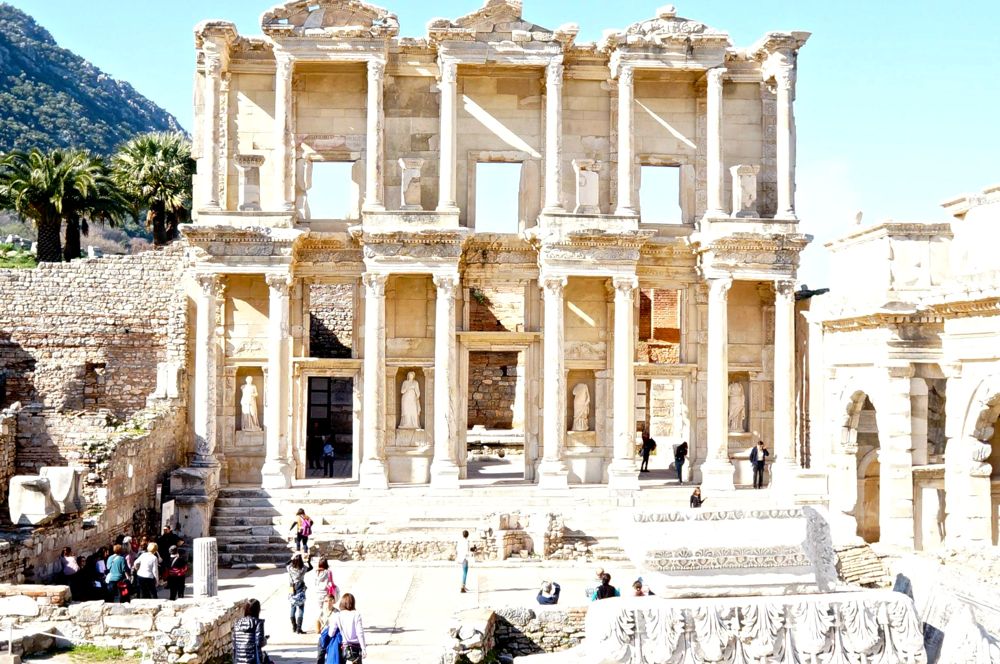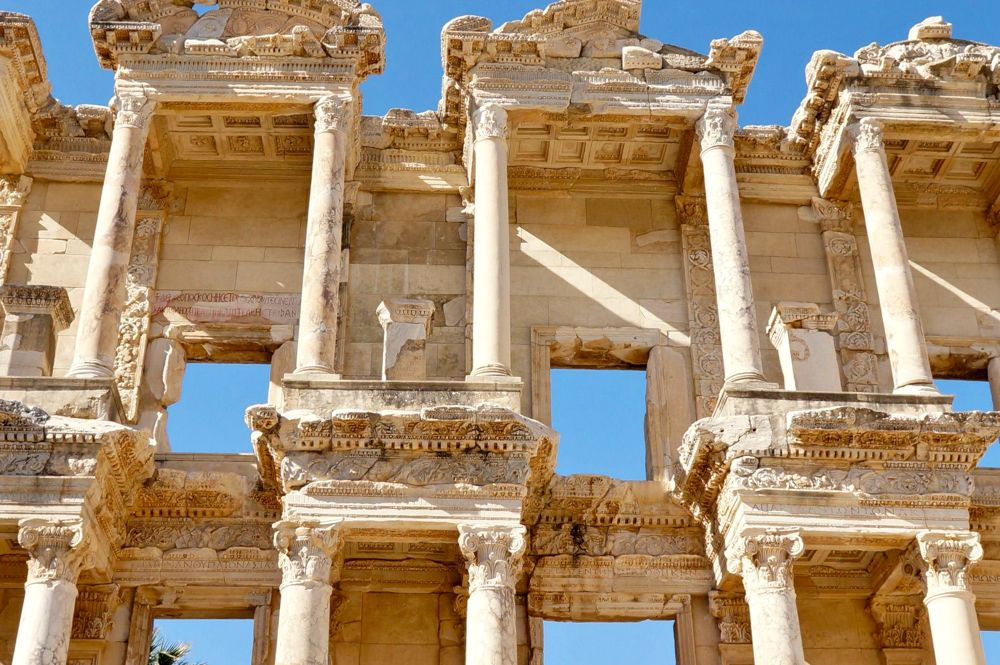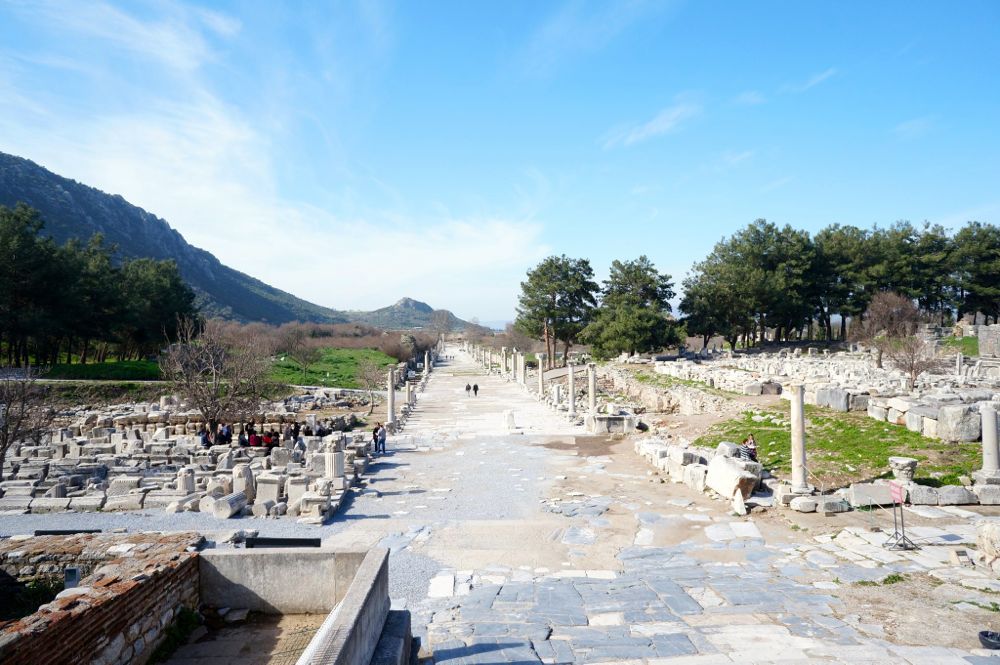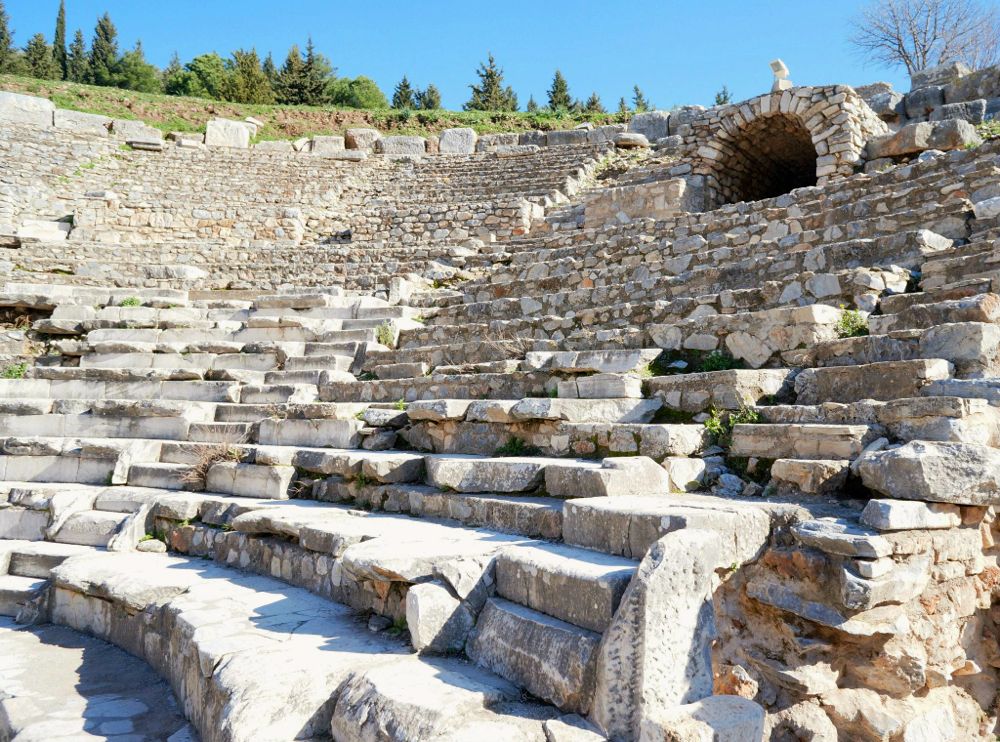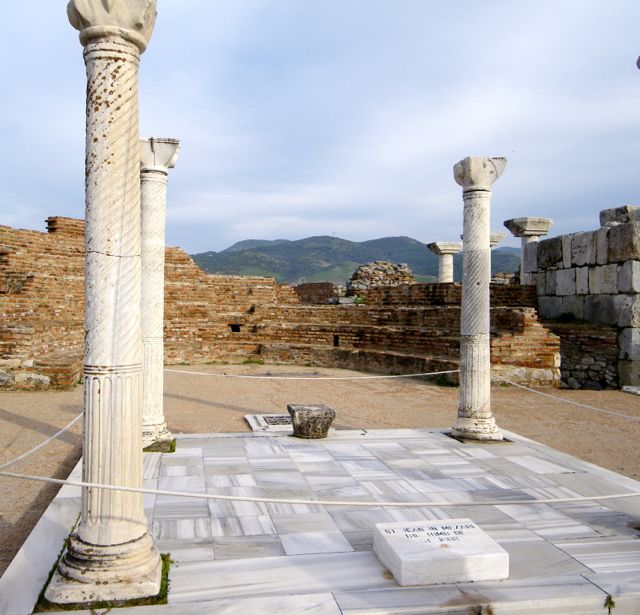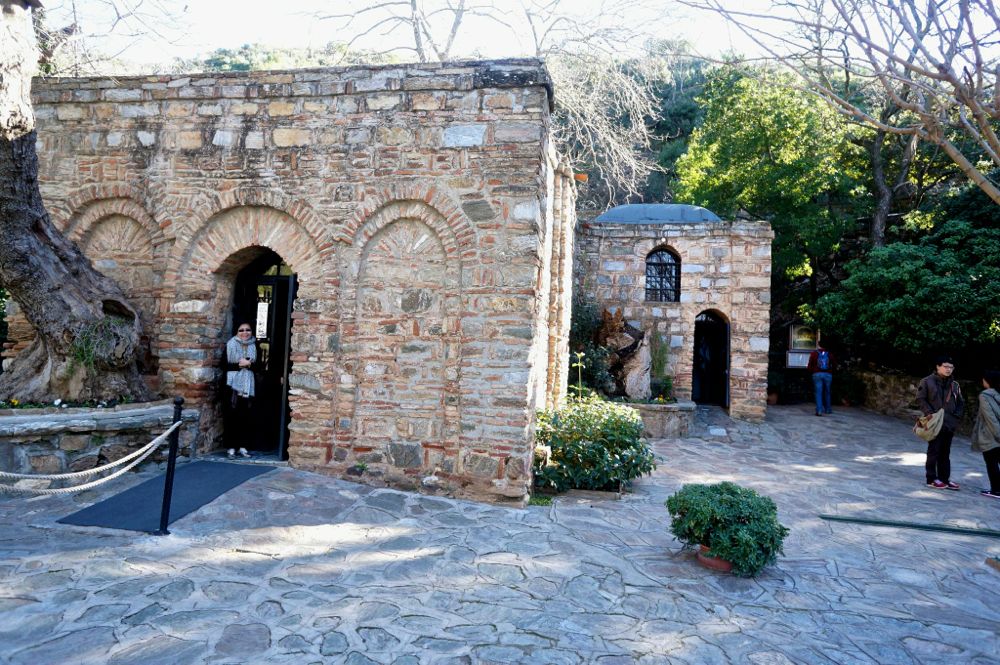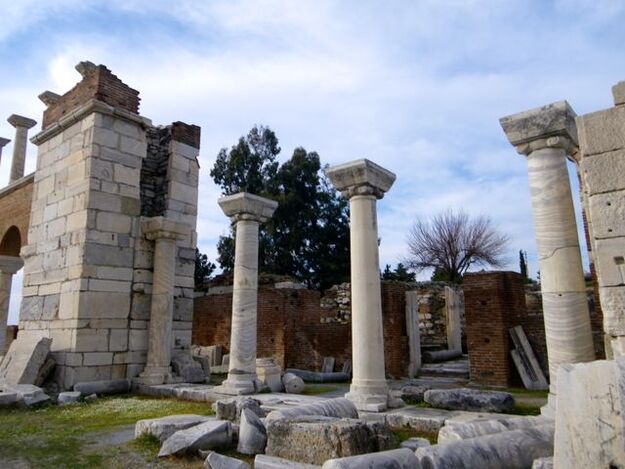Ephesus: The Biblical City of the Aegean
Have you ever wondered what it is like to live in the Biblical times? To be in Ephesus and listen to St. Paul and St. John or visit Mary in her house?
Sitting close to the Aegean, Ephesus has the answer. As a major port, it became the center of trade and culture, occupying a place of significance in the Bible.
So, while the great Easter crowds fill Israel to overflowing, a more peaceful way to think of Jesus, Mary, St. John the Apostle and St. Paul, and also the early Christians who lived and came through this city is to go to Turkey and walk through this Valley.
Sitting close to the Aegean, Ephesus has the answer. As a major port, it became the center of trade and culture, occupying a place of significance in the Bible.
So, while the great Easter crowds fill Israel to overflowing, a more peaceful way to think of Jesus, Mary, St. John the Apostle and St. Paul, and also the early Christians who lived and came through this city is to go to Turkey and walk through this Valley.
Ephesus is now about 5 miles from the Aegean Sea, but it used to be a significant port, so the city went right up to the water. What happened? The silt from the Cayster River kept changing the shoreline that brought Ephesus inland.
Now, it lies between two great rolling hills, and the beautiful valley is as peaceful today as it was two thousand years ago when Mary, Jesus' mother, lived there. My husband and I visited, and the place fascinated us no end.
Ephesus is blessed not just with some of the most beautiful scenic landscapes in the world but also with a significant and complex history. The remnants of this history, scattered throughout the Ephesian valley, enhance the beauty even further.
Now, it lies between two great rolling hills, and the beautiful valley is as peaceful today as it was two thousand years ago when Mary, Jesus' mother, lived there. My husband and I visited, and the place fascinated us no end.
Ephesus is blessed not just with some of the most beautiful scenic landscapes in the world but also with a significant and complex history. The remnants of this history, scattered throughout the Ephesian valley, enhance the beauty even further.
The Acts of the Apostles talk of this famous city in antiquity. As an important city, Ephesus has been the seat of several 5th-century Church Councils: the First Council of Ephesus in 431, the Second Council of Ephesus in 449, and the Third Council of Ephesus in 475.
St. John might also have written his Gospel here. Ephesus is one of the seven churches cited in the Book of Revelation.
St. John might also have written his Gospel here. Ephesus is one of the seven churches cited in the Book of Revelation.
Top Attractions in Ephesus
1. The Library of Celsus
The Library of Celsus is the most beautiful of the preserved buildings. Built in 135 to honour Celsus, the governor of Asia Minor, this was the third-largest library of ancient times.
When Cleopatra visited here, she was so impressed with the collection that she asked for these as a gift from Mark Anthony. The collections ended the Library in Alexandria and perished when the library got burnt.
I admired how well-preserved it still is. Imagine this place housing so many of the ancient records. The Library of Celsus is at the center of the ruins of the ancient city of Ephesus, and this place alone would take days to contemplate. One can come here and think of the early Christian times when those who first believed had to spread it cautiously, at the risk of losing their lives.
1. The Library of Celsus
The Library of Celsus is the most beautiful of the preserved buildings. Built in 135 to honour Celsus, the governor of Asia Minor, this was the third-largest library of ancient times.
When Cleopatra visited here, she was so impressed with the collection that she asked for these as a gift from Mark Anthony. The collections ended the Library in Alexandria and perished when the library got burnt.
I admired how well-preserved it still is. Imagine this place housing so many of the ancient records. The Library of Celsus is at the center of the ruins of the ancient city of Ephesus, and this place alone would take days to contemplate. One can come here and think of the early Christian times when those who first believed had to spread it cautiously, at the risk of losing their lives.
2. The Greco-Roman Ruins
Ephesus offers the best picture of life in the ancient Greco-Roman world. There are some of the best-preserved mosaics showing the advanced way of life of the people in Ephesus at that time. You can still see the design. Just imagine the streets paved in these mosaics.
On this road, paved with granite and decorated with statues of famous people at that time, Mark Anthony and Cleopatra and other ancient names we have read in history have walked.
But the center of life for this ancient, you will never guess. It is not a Cafe. It is the Latrine. Men send their servants to warm the marble seats, and then, they take over more to socialize with their friends and share the day's news.
As you stroll through the ruins, have a peek at how beautifully adorned the houses of the rich in Ephesus. Excavations are still going on in this area, and we will see more displayed in the future.
In these streets, I imagined St. Paul and St. John walking. It seems Timothy was also here. Mary, the Mother of Jesus, may have visited or lived here. The early Christians, some called themselves the Pauline group or the Johannine group, and even the Nicolaitans, indeed lived in this city.
Ephesus offers the best picture of life in the ancient Greco-Roman world. There are some of the best-preserved mosaics showing the advanced way of life of the people in Ephesus at that time. You can still see the design. Just imagine the streets paved in these mosaics.
On this road, paved with granite and decorated with statues of famous people at that time, Mark Anthony and Cleopatra and other ancient names we have read in history have walked.
But the center of life for this ancient, you will never guess. It is not a Cafe. It is the Latrine. Men send their servants to warm the marble seats, and then, they take over more to socialize with their friends and share the day's news.
As you stroll through the ruins, have a peek at how beautifully adorned the houses of the rich in Ephesus. Excavations are still going on in this area, and we will see more displayed in the future.
In these streets, I imagined St. Paul and St. John walking. It seems Timothy was also here. Mary, the Mother of Jesus, may have visited or lived here. The early Christians, some called themselves the Pauline group or the Johannine group, and even the Nicolaitans, indeed lived in this city.
3. The Temple of Artemis
One of the Seven Wonders of the Ancient World, the Temple of Artemis was a magnificent structure dedicated to the goddess Artemis. According to legend, the temple took 120 years to build. In 356 BCE, a fire destroyed it, but its ruins are still there.
Most of the people at that time worshipped Artemis. Their constant refrain was "Our God is Artemis". For the Christians, you have a glimpse of these times in what Paul wrote to the Corinthians: We do not want you to be uninformed, brothers, about the hardships we suffered in the province of Asia. We were under tremendous pressure, far beyond our ability to endure, so we despaired even of life. Indeed, in our hearts, we felt the sentence of death. But this happened that we might not rely on ourselves but on God, who raises the dead. He has delivered us from such a deadly peril, and he will provide us. (2 Cor 1:8-10).
Ephesus, with a population reaching about 225,000 at its height and mostly worshippers of Artemis, became a place for many early Christian missionaries like St. John and St. Paul to preach their new beliefs. As the letter to the Corinthians underlined, St. Paul was committed to getting a solid following in the area.
Read these lines from the letters St. Paul wrote to the Corinthians: If with merely human hopes I fought with wild animals at Ephesus, what would I have gained by it? (1 Cor 15:32) I do not want to see you now in passing, for I hope to spend some time with you if the Lord permits. But I will stay in Ephesus until Pentecost, for a wide door for practical work has opened to me, and there are many adversaries. (1 Cor 16:7-9)
One of the Seven Wonders of the Ancient World, the Temple of Artemis was a magnificent structure dedicated to the goddess Artemis. According to legend, the temple took 120 years to build. In 356 BCE, a fire destroyed it, but its ruins are still there.
Most of the people at that time worshipped Artemis. Their constant refrain was "Our God is Artemis". For the Christians, you have a glimpse of these times in what Paul wrote to the Corinthians: We do not want you to be uninformed, brothers, about the hardships we suffered in the province of Asia. We were under tremendous pressure, far beyond our ability to endure, so we despaired even of life. Indeed, in our hearts, we felt the sentence of death. But this happened that we might not rely on ourselves but on God, who raises the dead. He has delivered us from such a deadly peril, and he will provide us. (2 Cor 1:8-10).
Ephesus, with a population reaching about 225,000 at its height and mostly worshippers of Artemis, became a place for many early Christian missionaries like St. John and St. Paul to preach their new beliefs. As the letter to the Corinthians underlined, St. Paul was committed to getting a solid following in the area.
Read these lines from the letters St. Paul wrote to the Corinthians: If with merely human hopes I fought with wild animals at Ephesus, what would I have gained by it? (1 Cor 15:32) I do not want to see you now in passing, for I hope to spend some time with you if the Lord permits. But I will stay in Ephesus until Pentecost, for a wide door for practical work has opened to me, and there are many adversaries. (1 Cor 16:7-9)
The fact that Ephesus had been a strong follower of Artemis (Diana) must have also challenged the early Christians.
The Ephesians had inherited their goddess Artemis with glorious architectural commitment. They had built a temple to honour her, more significant than even the Parthenon.
This single last upright remnant may not show much, but the vast fields of tumbled marble bear witness to its size. Most of the finest carvings and statues are now in the British Museum and Hagia Sofia.
Paul's letter to the Ephesians had no mention of Artemis, and so it must have been a generalized letter to all Christians. Perhaps St. Paul was enough of a politician to try to avoid offending those whom he wanted to convert.
The Ephesians had inherited their goddess Artemis with glorious architectural commitment. They had built a temple to honour her, more significant than even the Parthenon.
This single last upright remnant may not show much, but the vast fields of tumbled marble bear witness to its size. Most of the finest carvings and statues are now in the British Museum and Hagia Sofia.
Paul's letter to the Ephesians had no mention of Artemis, and so it must have been a generalized letter to all Christians. Perhaps St. Paul was enough of a politician to try to avoid offending those whom he wanted to convert.
4. The Ancient Theatre
Ephesus had a significant and well-preserved theater that could accommodate up to 25,000 spectators. The theatre was not only used for plays and performances but also for political and religious gatherings.
One intriguing story is that the apostle Paul allegedly preached to the Ephesians in this very theatre, as mentioned in the Bible.You can just imagine the many people who would have listened to him thereby getting the ire of the authorities at the time. He was imprisoned but because he was a Roman citizen, he was not killed but brought to Rome.
For Christians and non-Christians alike, Ephesus remains one of the most powerful memories of our history over the past two thousand five hundred years.
Ephesus had a significant and well-preserved theater that could accommodate up to 25,000 spectators. The theatre was not only used for plays and performances but also for political and religious gatherings.
One intriguing story is that the apostle Paul allegedly preached to the Ephesians in this very theatre, as mentioned in the Bible.You can just imagine the many people who would have listened to him thereby getting the ire of the authorities at the time. He was imprisoned but because he was a Roman citizen, he was not killed but brought to Rome.
For Christians and non-Christians alike, Ephesus remains one of the most powerful memories of our history over the past two thousand five hundred years.
5. The Terrace Houses
The Terrace Houses in Ephesus were luxurious residences of the elite citizens during the Roman period. These houses were adorned with beautiful frescoes and mosaics, and they offer a glimpse into the daily lives of the wealthy inhabitants of Ephesus. The houses feature advanced plumbing systems, underfloor heating, and decorative elements that showcase the intricate craftsmanship of the time.
The Terrace Houses in Ephesus were luxurious residences of the elite citizens during the Roman period. These houses were adorned with beautiful frescoes and mosaics, and they offer a glimpse into the daily lives of the wealthy inhabitants of Ephesus. The houses feature advanced plumbing systems, underfloor heating, and decorative elements that showcase the intricate craftsmanship of the time.
6. The Basilica of St. John in Ephesus
St. John, the Apostle of Asia, is believed to have been buried here. There are records showing that St. John lived in Ephesus for a while. Jesus entrusted his Mother to John, so St. John brought her to live in this city, and her house is now one of the most visited places here.
St. John, the Apostle of Asia, is believed to have been buried here. There are records showing that St. John lived in Ephesus for a while. Jesus entrusted his Mother to John, so St. John brought her to live in this city, and her house is now one of the most visited places here.
7. House of Mary in Ephesus
No historical record could support that Mary, the Mother of Jesus, lived here. But many believed that because Jesus entrusted his mother to John, John must have brought her here when he lived here.
When you look at the picture, you can see the line where the old house ended. The upper portion is a later addition. Gregory of Tours first mentioned this place as being on top of a mountain near Ephesus. He wrote of the four walls without a roof where John lived.
No historical record could support that Mary, the Mother of Jesus, lived here. But many believed that because Jesus entrusted his mother to John, John must have brought her here when he lived here.
When you look at the picture, you can see the line where the old house ended. The upper portion is a later addition. Gregory of Tours first mentioned this place as being on top of a mountain near Ephesus. He wrote of the four walls without a roof where John lived.
A group of villagers from Kirkince, a village about 17 km. from this place, traditionally believed that it was from this place that Mary went up into heaven. So, each Assumption Day, August 15, these villagers come here walking for five hours on pilgrimage. They claimed that this tradition has been handed down from generation to generation.
The German seer, Anna Katharina Emmerich, saw the house of Mary in a vision. The details of this are in the book of Clemens von Brentano on Mary. This story guided the serious seekers, nuns, and priests who have read the book to find this ruined house with the mountain behind it and the sea in front.
In 2006, there was a forest fire in the area. The fire was massive, but as it approached the house, it suddenly stopped. Locals claimed there was no wind to blow the fire in another direction, and there was no sudden rainfall, no natural reason for the halt in the burning. It just stopped. Our Turkish guide said the only explanation is that it was a miracle.
Although the Church has not officially declared this place the last house Mary lived in, several popes have said Mass here, including Pope Paul VI, Pope John Paul II, and Pope Benedict XVI.
In the property is water from the redirected stream, which many deem miraculous. Pilgrims drink this water, believing it to have healing value.
The German seer, Anna Katharina Emmerich, saw the house of Mary in a vision. The details of this are in the book of Clemens von Brentano on Mary. This story guided the serious seekers, nuns, and priests who have read the book to find this ruined house with the mountain behind it and the sea in front.
In 2006, there was a forest fire in the area. The fire was massive, but as it approached the house, it suddenly stopped. Locals claimed there was no wind to blow the fire in another direction, and there was no sudden rainfall, no natural reason for the halt in the burning. It just stopped. Our Turkish guide said the only explanation is that it was a miracle.
Although the Church has not officially declared this place the last house Mary lived in, several popes have said Mass here, including Pope Paul VI, Pope John Paul II, and Pope Benedict XVI.
In the property is water from the redirected stream, which many deem miraculous. Pilgrims drink this water, believing it to have healing value.
Ephesus is the best preserved of the ancient cities on the eastern shore of the Mediterranean. They are still excavating and restoring the place. So, for history buffs, this city is fascinating.
For Christians, this would be an exciting pilgrimage to remember the early Christians and the world they were in. How did they practice their faith? How did they become believers in Christianity? How did they share this new belief with others?
For Christians, this would be an exciting pilgrimage to remember the early Christians and the world they were in. How did they practice their faith? How did they become believers in Christianity? How did they share this new belief with others?
Ephesus and Christianity
Ephesus played a vital role in the spread of Christianity. The apostle Paul spent several years in Ephesus preaching and establishing a Christian community.
A few notable references in the Bible mentioned Ephesus:
1. Acts of the Apostles: In the book of Acts, the apostle Paul visited Ephesus on his missionary journeys. He stayed there for approximately three years (Acts 19:1-41) and established a significant Christian community in the city. Paul's ministry in Ephesus included preaching, performing miracles, and teaching about Jesus Christ.
2. The Letter to the Ephesians: The Epistle to the Ephesians, written by the apostle Paul, is addressed to the Christians in Ephesus. This letter contains teachings on various aspects of faith, including God's plan of salvation, unity within the church, and living a Christ-centered life. It highlights the importance of love, faith, and spiritual warfare.
3. Revelation: The city of Ephesus in the book of Revelation is one of the Seven Churches of Asia (Revelation 2:1-7). The letter to the church in Ephesus addresses their commendable deeds but warns them about losing their first love for Christ. It emphasizes the need for repentance and perseverance to overcome challenges and receive eternal rewards.
4. 1 Timothy: In the first epistle to Timothy, Paul instructs his fellow disciple Timothy, who was based in Ephesus then, on the responsibilities of church leadership and the conduct of believers. This letter guides combating false teaching, appointing elders, and maintaining order within the church.
These passages illustrate the significant role Ephesus played in the early Christian movement and the establishment of Christian communities. The biblical references to Ephesus provide insights into the challenges, teachings, and spiritual growth experienced by the early Christians in that city.
Ephesus played a vital role in the spread of Christianity. The apostle Paul spent several years in Ephesus preaching and establishing a Christian community.
A few notable references in the Bible mentioned Ephesus:
1. Acts of the Apostles: In the book of Acts, the apostle Paul visited Ephesus on his missionary journeys. He stayed there for approximately three years (Acts 19:1-41) and established a significant Christian community in the city. Paul's ministry in Ephesus included preaching, performing miracles, and teaching about Jesus Christ.
2. The Letter to the Ephesians: The Epistle to the Ephesians, written by the apostle Paul, is addressed to the Christians in Ephesus. This letter contains teachings on various aspects of faith, including God's plan of salvation, unity within the church, and living a Christ-centered life. It highlights the importance of love, faith, and spiritual warfare.
3. Revelation: The city of Ephesus in the book of Revelation is one of the Seven Churches of Asia (Revelation 2:1-7). The letter to the church in Ephesus addresses their commendable deeds but warns them about losing their first love for Christ. It emphasizes the need for repentance and perseverance to overcome challenges and receive eternal rewards.
4. 1 Timothy: In the first epistle to Timothy, Paul instructs his fellow disciple Timothy, who was based in Ephesus then, on the responsibilities of church leadership and the conduct of believers. This letter guides combating false teaching, appointing elders, and maintaining order within the church.
These passages illustrate the significant role Ephesus played in the early Christian movement and the establishment of Christian communities. The biblical references to Ephesus provide insights into the challenges, teachings, and spiritual growth experienced by the early Christians in that city.
Read more on Travel:
